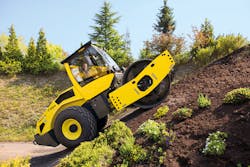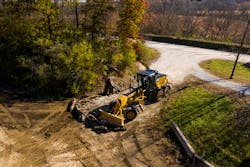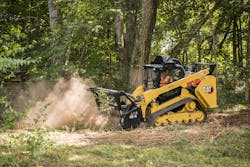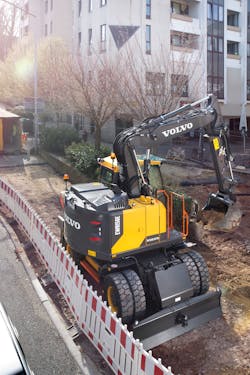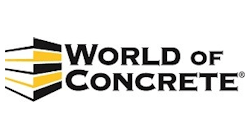The nature of road-building hasn’t changed much over the years: earthworks, building a foundation, creating an embankment and paving the sub-base, base and top layer according to traffic load and weather conditions.
But the technologies being used to execute each step have become more advanced, creating more efficiencies, enhancing safety, and extending road lifespans.
Case in point: intelligent compaction (IC).
“In the U.S., much of our infrastructure has been built and we're not seeing as much new construction except for a new interstate connection or a bypass around a city. However, in many areas of our country, it has come time for reconstruction,” says Mark Eckert, compaction product manager for Volvo.
“In the maintenance we're doing around the country, we’re able to see the compaction job on the top of the road is good, but we're not able to see what happened when it was built. When it comes to reconstruction, it’s everything from the earth underneath - the base materials - all the way up to the topcoat.”
In building new roads, an intelligent compaction system placed on soil compactors enables contractors to map out every layer.
Thus is the future in building new roads, he adds.
“Some projects are also using thermal mapping technology with pavers. This documents temperature as the material is placed and helps coordinate plant and trucking operations,” says Eckert.
“Budget concerns continue to challenge federal and state agencies, so having roads that last longer is beneficial.”
IC has taken a lead role in road construction because, with the industry focus on safety and budgets, about half of U.S. states have intelligent compaction specifications, says Eckert.
In addition to contractors who use IC due to agency specs, other contractors use it simply because of its benefits, says Eckert.
The road construction value stream consists of eight phases comprising the individual work segments to complete a construction project from the time an owner—be it a developer or a transportation department—identifies a need through asset maintenance and operation.
The value stream starts with the planning and programming phase.
That phase is followed by the preliminary design, engineering development, right-of-way and utilities, bidding, preconstruction, construction, and operations and maintenance phases.
The planning and programming phase entails the identification of needs such as roadway expansion followed by project authorization and compliance with planning requirements, then concludes with construction funding stream identification.
The construction funding stream can emanate from various delivery methods.
“Currently, public-private partnerships—known as P3s—are growing in popularity,” says Lonnie Fritz, a senior market professional in construction industries at Caterpillar. “Instead of transportation departments laying out 100% of the project cost with their transportation funds, they look to share the risk of the project design development and a portion of the funding requirements with a private company.”
In the preliminary design phase of the traditional design-bid-build project delivery phase, data collection and preliminary design parameters are collected and public meetings are held to convey the proposed project plan and ascertain impacts to protected areas, notes Fritz.
Then, preliminary site and geometric plan drawings are developed, engineering value is derived, and geometric plans are approved.
The third phase—engineering development—includes the development of a detailed design to illustrate project amenities and final alignment and profiles.
The horizontal alignment stretches the length and distance of the project from the beginning to the end defining the location of the road. The vertical alignment defines the roadway’s elevations. Alignment determination is applied to create the roadway and operational designs.
The engineering development phase of the road construction value stream also consists of creating the drainage design, encompassing stormwater mitigation efforts; structures, retaining and noise walls, and miscellaneous structures; and traffic control plans to ensure safe access and egress throughout the project.
The fourth phase is right-of-way and utilities. Right-of-way and utility line location, descriptions, and ownership data are collected and noted in the design. Appraisals for land acquisition need to accommodate expansion, and alignment shifts are conducted Required utility adjustments also are determined and incorporated into the design.
The estimating and bidding phase often starts with a pre-bidding meeting, which commonly includes the owner, design engineers and pre-qualified contractors interested in bidding on the project.
Next, project estimating commences with the estimate including all resources—labor, material, and equipment—to complete the project being bid.
“The bid includes the total estimated cost and overhead cost to complete the project plus the percentage of markup and the desired profitability added to the estimate,” notes Fritz.
The successful bidder enters the sixth phase—the pre-construction phase—after being awarded the contract. During this phase, the project management team begins detailed planning of construction execution.
“When I was a project manager, I lived by the saying ‘plan your work, work your plan, and make adjustments as necessary’,” says Fritz.
The preconstruction phase includes project planning; material, personnel, and equipment scheduling; approvals; long lead item procurement; mobilization coordination, and often the establishment of field offices.
After its completion, it’s time to execute it.
“This is where the tracks hit the dirt,” says Fritz. “The project management team is fully engaged, and the seventh phase – the construction phase – commences.
“If you’re on a project with existing pavement, commonly the concrete and/or blacktop pavement is removed,” he adds. “Due to sustainability metrics and depleting natural resources, the removed pavement is often processed for use on the same project or stockpiled for use on a future project.”
Once the pavement is removed, the earthmoving phase starts if horizontal alignment and/or elevation changes are designed into the project.
"If the material is to be removed, the area is known as a cut area and where the material is to be added to achieve subgrade elevation, the area is known as a fill area," says Fritz.
“Underground utility installation also factors into the timing of the earthmoving operation. Depending on the grades, cutting down an area will benefit underground utility installation by requiring less trench excavation. Conversely, a fill area may need to be partially or fully constructed to accommodate the underground utility installation. Once the underground utility installation and earthmoving are finished, base course, paving, and finishing operations are completed. The project is complete, the ribbon is cut, the traffic is flowing.”
The eighth and final phase is operations and maintenance. Items often included in this phase are crack routing and sealing, surface removal and pavement overlaying, raised reflective pavement marker installation, and restriping of pavement markings.
“When longitudinal, transverse, and/or reflective cracks start to occur, a pavement analysis is conducted to determine the best-suited maintenance approach," says Fritz. "Routing and sealing and surface removal and pavement resurfacing are the two most common maintenance methods performed to preserve the pavement structure and reestablish a new surface, in the case of pavement overlays."
Cat cold planers, also known as milling machines, are used to plane off a certain depth of the existing pavement material in preparation for an asphalt pavement overlay. Concrete overlays, also known as whitetopping, provide another type of overlay surface used to preserve the underlying pavement structure.
Caterpillar offers the construction industry more than 300 machine and technology products and the necessary services designed to maintain and monitor fleet health, maintenance, and performance and maximize efficiency, production, and safety such as Grade, Payload, Compact, Command, Link, and Detect.
Starting with tree-clearing and brush removal—often the first of many construction activities on a project—Caterpillar offers a range of hydraulic excavators, dozers, and skid-steers and a variety of attachments that are configurable and designed to complete clearing tasks safely and efficiently.
Jobs designed with a horizontal and vertical alignment requiring cut through a rock formation can be accomplished with Cat drills, excavators, dozers, and rigid-frame and articulated trucks.
For hot mix asphalt and concrete pavement removal, that’s the time to leverage the Cat cold planer, notes Fritz, adding a hydraulic excavator is commonly used for full-depth concrete removal. Leveraging Cat Production Measurement Payload (CPM) technology during pavement removal operations is critical to ensure an optimized payload on hauling units.
“To expedite the concrete pavement removal process, a dozer is used to consolidate and push the loose material to the excavator as it loads the debris on to on-highway trucks or articulated dump trucks,” he says. “To practice sustainability, especially on larger projects, the removed material is hauled to a crusher o-site or an adjacent site, crushed and processed, and used as base course.”
Caterpillar offers numerous earthmoving machines including excavators, articulated trucks, dozers, wheel-tractor scrapers, rigid-frame trucks, soil compactors, and motor graders.
Fritz points out that on equipment such as Caterpillar’s next-generation non-GC hydraulic excavator line-up, Cat Grade with Assist technology helps operators achieve a grade in the fewest number of passes and with the greatest amount of accuracy.
“Significantly increasing production up to 45 percent using Cat 2D Grade with Assist allows the excavator to go onto the next task quicker, driving down unit cost while increasing profitability and company growth,” says Fritz. “Also included on the non-GC next-generation Cat excavators is CPM Payload technology.”
Payload technology prevents the overloading of trucks. Overloading contributes to accelerated wear, increased fuel burn and increased safety risks by potentially exceeding braking capacity, which could lead to an accident, notes Fritz.
Conversely, underloading hauling units increase trucking cost and the potential for schedule delays, he adds.
Contractors capture the greatest profit potential by ensuring their trucks are loaded with the maximum payload they can legally and safely carry, says Fritz.
Payload technology also reduces cycle time to an optimal level because the operator loading the truck is hitting the target payload in the fewest number of passes as efficiently and quickly as possible, he adds.
CPM Payload technology is an available option on Cat articulated trucks. A tool called Payload Estimator is configurable on Cat wheel-tractor scrapers.
CPM Payload technology solutions provide the operator and management team clear insight into the quantity of material moved by load, by shift and other configurable metrics.
Cat’s non-GC next generation excavators come standard with 2D E-Fence ease-of-use safety technology. The 2D E-Fence technology suite includes E-Wall Ceiling, E-Wall Floor, E-Wall Forward, E-Wall Cab Protection and E-Wall Swing.
The 2D E-Fence features require the operator to establish the limits of the working envelope. These limits automatically prevent the machine’s front linkage boom, stick and work tool attachment from working outside of the preset parameters.
The 2D E-Wall Ceiling prevents the excavator linkage from encountering overhead objects while E-Wall Floor prevents the attachment from encountering objects below grade. E-Wall Forward prevents the front linkage from encountering an object in front of the attachment while E-Wall Cab Protection prevents the attachment from contacting the cab.
E-Wall Swing prevents the front linkage from swinging outside of the working arc set by the operator.
Most Cat machines come standard with rear vision camera systems. To maximize visibility and safety, Cat offers 360-degree camera systems on some products from the factory. Object Detection and Collision Avoidance also are available on some Cat models.
Track-type tractors continue to become smarter, says Fritz.
"Available with 2D and 3D Grade control systems, dozers have pushed their way to greater job site productivity and efficiency gains by eliminating rework and material overruns all while achieving grade accuracy in the fewest number of passes," he says.
Cat dozers are designed for ease-of-use productivity with enhancement features that include Cat Grade with Slope Assist, Stable Blade, Auto Carry and Blade Load Monitor.
“A 3D digital design file is loaded into the 3D Grade control system in the cab, fully empowering the operator with all horizontal and vertical alignment information that he or she needs to have to accomplish the task at hand,” says Fritz.
“Operating using 3D Grade control, be it day or night, increases safety and produces the highest quality work.”
Cat Motor graders, hydraulic excavators, wheel-tractor scrapers, pavers, cold planers are all configurable with 3D Grade control technology.
“Grade control reduces fuel burn and accelerated wear and is a solution for making a good operator great, one answer to the skilled operator shortage the industry continues to manage through,” Fritz points out.
Cat’s track-type tractor Blade Load Monitor system informs the operator of the blade load being pushed so adjustments to the cut can be made by the operator to optimize blade capacity and productivity, says Fritz.
Fritz points out that Cat’s soil compactors are configurable with Machine Drive Power (MDP) intelligent compaction technology, a Cat exclusive technology product that measures material stiffness during the compaction process.
The operator receives a real-time relative reading of the soil stiffness of the material as it is being compacted. A nuclear density gauge is commonly used to test soil compaction to ensure the moisture and density levels comply with the project's compaction specifications. The operator notes the relative reading that the machine is displaying at the same location the passing compaction test was taken. The operator continues with the compaction process making the minimum number of passes to achieve at least the relative number displayed where the compaction test was taken.
For example, if a passing compaction test is taken and the Cat Machine Drive Power system displayed a 125 at the same location the test was taken, the operator will make passes with the compactor until a minimum reading of 125 is achieved across the area to be compacted.
The addition of Global Navigation Satellite System (GNSS) mapping gives the operator full visibility of compaction coverage.
“Utilizing Machine Drive Power intelligent compaction and GNSS mapping technologies, the contractor has peace of mind knowing that compaction for the entire surface has been achieved in the fewest number of passes,” says Fritz. “Other benefits include a reduction in fuel burn, machine wear and material overruns while eliminating rework and schedule delays resulting from failed compaction tests."
Although compaction accounts for approximately five percent of the earthmoving cost, "it is the most important part of the entire earthmoving and material installation process,” says Fritz. “If the current lift does not pass compaction, placement of the subsequent lift or activity for that area, whether it be soil, base course or whatever material is to be put down will be prohibited until passing compaction results are achieved.”
Finish grading is commonly achieved with motor graders, dozers or a combination of both machine types depending on the application. These machines are used to achieve a desired level of precision and overall accuracy across the job site.
“Leveraging technology on the motor grader is key,” says Fritz, adding that Caterpillar has integrated 3D mastless GRADE control technology on some of its common models in the motor grader product lineup. The mastless 3D GRADE control system also is retrofittable on many existing motor grader models.
Underground utility construction—prevalent on most projects—is performed using a variety of machines depending on the application. That could include utility depth, pipe and structure sizes and weights, trench protection equipment, soil type and underfoot conditions.
Caterpillar’s hydraulic excavators, wheeled excavators, backhoe loaders, track-type loaders, wheel loaders, skid steers, multi-terrain loaders, dozers and soil compactors are used as excavation, support, backfilling and compaction machines.
The excavator is commonly used to dig the trench into which the pipe is set, followed by the loaders, which serve as support machines bringing in pipe, structures, fittings, bedding material and trench backfill material to support the excavator in the installation process.
“The soil compactor and/or compaction attachment work in tandem with the backfilling process to provide compaction in the trench to prevent settlement of the pavement or any other structure that will be constructed or set on top of the utility run,” says Fritz. “The use of Cat 2D and 3D GRADE control technology, payload technology and intelligent compaction technology into an underground utility operation significantly increases safety, productivity, profitability and quality of work.”
Soil stabilization and pavement rehabilitation are often in scope on a construction project.
For example, if a contractor is working on a project that calls for the soil to be lime modified to achieve the load-bearing strength needed to support the pavement structure, a building structure or any other use case, Cat offers products that best serve the stabilization application, notes Fritz.
“Caterpillar’s lineup of soil stabilizers thoroughly mixes the soil and add mixture together to create a homogenous material, a pad foot or tamping foot compactor that compacts the soil to achieve compaction,” he says. “At this point in the operation, a dozer is often utilized to achieve grade within a tenth of a foot and a motor grader and/or trimmer are used to bring the surface to finish grade elevations.”
After the subgrade is completed, the aggregate base course is constructed, says Fritz.
“One common way is using truck dumps of aggregate spread by dozers or motor graders, a method with high productivity potential if the take rate and placement rate are in sync,” he says.
“The other common way of placing aggregate base course is using a paver, which is ideal for applications in a confined area. For example, on a roadway where the mainline base course and pavement are being replaced and the existing shoulders remain, a paver is the most conducive machine to use to pave consistently to grade and width the lift of aggregate base.”
Fritz points out that Cat elevated scrapers are useful for windrow clean-up and shuffling of subgrade and base course materials from one location to another during the finish grading process of both surfaces.
Support machines such as backhoe and skid steer loaders work well in corners and other tight areas to shuffle and grade material, says Fritz.
Cat offers a full line of compactors for compacting the aggregate base course to the compaction specifications of the contract. Grade control and intelligent compaction technology solutions deliver the highest quality results at the lowest possible unit cost during the aggregate base course facet of the project.
Pavement construction generally follows the aggregate base course operation on a job site in the construction phase.
“The type of pavement structure – concrete or hot mix asphalt – on a construction project is determined by many factors including intended use, traffic count and vehicle types, expected new pavement life before maintenance, material availability and cost and future maintenance options,” says Fritz.
“Pavement structures are commonly made of full-depth hot mix asphalt pavement, concrete pavement – jointed or continuously reinforced – or a pavement structure consisting of a hot mix asphalt base course with a concrete pavement surface.”
Generally, pavements are a minimum of 10 inches thick.
Machines used to construct mainline concrete pavements include a belt placer or material transfer vehicle (MTV), a machine that intakes the imported concrete material from dump trucks and distributes it in front of the concrete paver.
If the project is being supplied by ready-mix concrete, the ready-mix trucks discharge their load in front of the concrete paver.
The concrete paver is followed up by the finishing machine and concrete finishers performing handwork to create a smooth and sealed off wear surface. Some project specifications require a textured and/or tined surface completed by a machine.
Caterpillar paving and technology products also serve the asphalt paving industry, notes Fritz.
“One of the keys to paving a smooth mat is constant head pressure on the screed of an asphalt paver,” he adds.
The second key to producing a smooth pavement surface is consistency. Consistency in asphalt paving is accomplished the same way it is in concrete paving, using an MTV. The CAT MTV is made by its partner Weiler.
“The asphalt is dumped out of a truck and into the MTV's hopper where the material is then transferred to and remixed in the storage hopper before being discharged from the MTV into the receiving hopper of the asphalt paver,” says Fritz.
“The utilization of an MTV in the paving train allows for continuous paving while trucks are pulling away and backing up into the material transfer device. It also prevents bumping of the paver where the screed potentially puts an indentation into the mat that has just been laid.”
The remixing process significantly reduces material segregation, which is the demise of asphalt pavement longevity, notes Fritz.
Additionally, the use of an MTV helps maintain the specified temperature of the asphalt mixture, a necessity for achieving specified compaction targets, he adds.
MTVs on the upper end of the capacity charts carry approximately 25 tons of asphalt material. Asphalt pavers are available in different sizes and configurations.
“The key difference in the configuration of a paver is whether it's on a rubber-tired or belted track undercarriage, several screed options are also available depending on paving application needs,” notes Fritz.
Caterpillar paving technology advancements have evolved from factory-integrated 2D GRADE depth and cross slope GRADE control to plug and play options to add 3D Universal Total Station grade control designed to easily accomplish paving line and grade to millimeter accuracy.
Thermal imaging camera technology is the newest technology available on Cat pavers. A thermal imaging camera mounted on the mast of the paver scans the mat behind the screed, providing the paving crew complete visibility of the mat temperature depicting zones where the asphalt mixture temperature is inconsistent with other areas of the mat.
Having this information allows for process management and resolution if pavement temperature is nearing the lower end of the specified temperature range required to achieve compaction, notes Fritz.
Caterpillar offers a wide range of compactor types and sizes for the asphalt paving industry, including dual steel drum, pneumatic and combination steel and pneumatic tire compactors, says Fritz.
Several of Caterpillar’s vibratory asphalt compactors can be configured with Compaction Meter Value (CMV) intelligent compaction and GNSS mapping technologies.
“CMV measures material stiffness and when GNSS mapping is configured on the compactors, machine-to-machine communication may be transmitted between the compactors so each operator can see exactly where his/her peers have or have not compacted the mat,” notes Fritz.
As the asphalt compactors make their passes, the GNSS mapping system “paints” each pass on the operator’s monitor showing where the pass was made and in the color set to correspond with the material stiffness achieved at that specific location.
Combining the CMV intelligent compaction system with GNSS mapping ensures that the compactor operators are achieving specified compaction targets in the fewest number of passes across the entire mat of asphalt.
“Intelligent compaction is gaining popularity in project specifications by governmental agencies and design engineers with private firms who are seeing the benefits and value intelligent compaction and mapping provide to paving efficiencies and quality improvements,” says Fritz. Compaction data can be easily downloaded in the back office for project monitoring and documentation.
“A consistent, uninterrupted pace and head of material on the screed are the keys to any asphalt laydown operation,” notes Fritz.
To track and provide transparent visibility into the transportation of the asphalt mixture from the plant to the paver and the return of the trucks back to the plant, Caterpillar developed eRoutes, a web-based computer software and mobile app that enables customers to quickly see where the company-owned and/or for-hire trucks are and when they will arrive at a job site or return to the plant.
The goal is to align project laydown and material delivery by adjusting the paving operations based on information flowing in from the app.
“eRoutes drives proactive job site management and optimizes assets to get the greatest productivity and quality during the laydown process,” Fritz states.
After mainline asphalt paving is completed, asphalt and/or aggregate shoulders are constructed.
Through Weiler, Caterpillar offers a line of road widener products enabling the material to be dumped into the road widener’s hopper and spread longitudinally down the edge of pavement to create the asphalt or aggregate shoulder.
Finishing work—the final work segment commonly found near the end of any project schedule—includes erosion control measures such as topsoil, aggregate and other erosion preventing and maintainable treatments.
Proposed green areas requiring topsoil are often built by a fleet of trucks hauling the topsoil that has been loaded by an excavator or wheel loader and is spread and graded by a dozer or motor grader.
Smaller areas can best be addressed using a skid steer to place and grade topsoil. Seeding, mulching and other treatments to prevent erosion are readily used to establish growth to lock in the topsoil. Ditches, slopes and areas susceptible to high amounts of watershed are often constructed out of rip rap, aggregate material having a large gradation.
Volvo’s wheeled excavators play a critical role in initial road preparation.
“Say you're trying to clean up the job site before you start laying any of the materials down,” says Matthew McLean, excavator product manager, Volvo Construction Equipment. “With most wheeled excavators, you put some kind of tilt rotator or other attachment on the end.
“If you're cleaning up the land, you could use a brush cutter and knock down all the vegetation before other machines get there. There are grading beams you can use to smooth out the dirt, and trenching buckets to install utilities before the road work begins.”
Wheeled excavators offer flexibility as they travel between jobs faster than a crawler, McLean notes.
“You can put this into a creep speed or low speed to do your cleanup work,” he says. “If you're doing a road expansion or road repair, you can't block off all the existing lanes of the traffic. But you can use a short-swing wheeled excavator and minimize the amount of interference you're going to have with your machinery. You can block off one-lane traffic and have the ability to completely rotate and do your work without going into the next lane of traffic.”
Repairs and maintenance also are issues in road construction and Volvo’s wheeled excavators serve as tool carriers. They also can tow a trailer.
“You go to a road site and you're going to have to put up barriers or some other safety protection where there's going to be cones and jersey barriers. But if you're towing your trailer, you can have those materials already with you,” says McLean.
“Maybe you'll have water-filled barriers. You'll drop those and perhaps you have two or three attachments. All of your work tools and safety gear are in that trailer.”
In Europe, McLean has seen contractors use dump trailers with high walls as they move material from site to site, using the power of the excavator to dump the material.
Volvo's wheeled excavators provide multiple functions in one machine, notes McLean. Multiple hydraulic circuits offer choices from low- to high-pressure flows.
“If you have a rotating grapple, the high flow circuit does the opening and closing and the low flow circuit does the rotation,” he says. “With tilt rotators and a Steelwrist, you only have to send out one circuit to the front because those devices all have their own valves in them and can have up to five circuits at the attachment.
“They have one to rotate it, one to pick it up and drop it, one for the cylinders to angle it left to right, and then there's usually an auxiliary circuit that you can use to put a powered attachment below the Steelwrist or whatever brand of tilt rotator you happen to be using.”
A tamper can be picked up with the Steelwrist and used to tamp down the soil or whatever needs to be flattened, McLean adds.
Having the ability to use multiple attachments means the equipment can stay on-site to build the various road layers, McLean points out.
The wheeled excavators can be used 24 hours a day with light packages that feature 11 different LED lamps and a key fob that can be used to turn the lights on while approaching the equipment in the dark.
Volvo wheeled excavators offer mobility with short swings, flexibility through a minimal footprint, and the ability to use a variety of attachments.
“If you’re doing cleanup work and backfilling material, you also have a parallel blade on the front,” says McLean. “Then you’ve also got the hydraulics and quick couplers any attachment you want.”
In addition to the light package, safety features also include alerts for when the operator is not wearing a seatbelt.
Dig Assist software is machine control for excavators designed to guide an operator to dig with precision. An upgrade to Trimble or Topcon gives the contractor access to the same job file used by the dozers, scrapers, and rollers "so, at the end of the day, everybody is working to the same end goal on the project,” notes McLean. “That’s going to be helpful, given how big some of these road jobs are and the huge civil engineering site file there is to work with.”
Volvo Construction Equipment offers a line of asphalt and soil compactors for the road-building market, particularly for hot or warm mix asphalt flexible pavements.
Rollers are simple machines to operate that typically don’t have a specialized operator as an excavator or motor grader would, says Eckert.
“Our biggest goals are safety and ease of use,” he adds.
As a result, many safety features have been built into the equipment, such as an operator presence switch that shuts the machine down when the operator vacates the seat. Also integrated into the equipment: seat belt alarms, emergency stop systems and parking brake testing.
Volvo machines also feature eight amplitude settings to incrementally increase or decrease compaction depth and change the drum energy. The variability offers the ability to use the right amount of compaction to get density in fewer passes and in less time, says Eckert.
The Volvo DD128C, released in 2020, not only offers eight amplitude settings but also five frequencies. Lower amplitudes have higher frequencies to optimize rolling speeds
“You can drive faster and not have too few impacts per foot, offering smoothness and rideability,” says Eckert. “In road construction, the objective is to build a good long-lasting road as well as a safe, smooth road.”
Flexible pavement is quieter and offers a smoother ride, with durability for its lifespan, notes Eckert.
“In the U.S., the concept has been to build a road that will last 50 years and without a major failure,” says Eckert. “The key to that is the subgrade and the road base. When you get to the top layer, if you build a road right—which is the perpetual pavement concept—you only replace the wearing surface every several years.”
Rollers play a key role in getting uniform density when building a road, says Eckert.
“The key to road life for longevity is density,” he adds. “Achieving density starts with the paver, which lays down the material somewhere above 80 percent. That means that 20% is air voids.
“The roller or roller train in most cases is going to try to get that density up to somewhere between 92 and 96 percent with a four percent air void. When compaction gets it to that level, it speaks to how long the pavement is going to last.”
Roadbuilding starts with good subgrade compaction, notes Eckert.
“If you look at a job site, there's a lot more that goes on with roadbuilding whether you're building a concrete road or a perpetual pavement road that starts from the base,” he says.
There has been significant industry focus over recent years on density, with intelligent compaction (IC) answering the call to attain that, notes Eckert.
“It equips the roller with technology that can help the operators achieve their rolling pattern. The GPS on the roller puts information on a screen where contractors can look at it and see their passes in color,” he adds. To bolster safety, Volvo screens have a day mode and a night mode so contractors can see to the best of their ability.
“Color pass mapping can help operators see if their rolling pattern matches the pass target. When rolling a flexible pavement, it’s hard to see where you have rolled after your first or second pass.”
Not only does intelligent compaction reveal passes made, but it also records temperature so the contractor can know what the material temperature is during each pass.
“If equipped with a sensor that provides estimated density or CMV (Compaction Measurement Value), you can see the material getting more compacted on the display screen in front of you,” notes Eckert. “Plus, you can look at everything and match it up with all of the quality control tests.”
Intelligent compaction helps prevent both under rolling and over rolling, he points out.
“If you over-compact, you can start fracturing aggregates,” says Eckert.
Volvo’s machines are designed to enable a contractor to estimate density and see a stiffness value.
BOMAG offers a broad spectrum of machinery for road-building, including asphalt rollers, pavers and feeders, single drum rollers, soil compactors, cold planers, recyclers, and stabilizers.
The company’s asphalt finishers, pavers, and asphalt compaction machines are designed for use in constructing asphalt roads.
For concrete, BOMAG offers machinery for soil preparation for the base preparation to stabilize the material before compacting it and preparing it for the installation of the concrete road.
Properly stabilized material and properly compacted soil conditions are the basis for having a road that can sustain without cracking, says Bert Eerdman, product manager for compaction equipment for BOMAG.
BOMAG offers steel drum rollers capable of controlling the output of the vibratory drums that helps with minimizing or eliminating over-compaction.
“When that happens, you would start destroying the aggregates,” says Eerdman. “The only way to correct that problem is to go back and restabilize the soil. It will be a very time-consuming and expensive type of repair.”
BOMAG’s self-regulating drums are designed to make over-compaction “almost impossible,” he adds.
BOMAG’s Asphalt Manager automatically controls compaction. The amplitude continuously adjusts to the level of compaction already achieved, avoiding over-compaction and drum bounce, and it can be used near structures without risk of vibration damage.
BOMAG also offers a Telematic app to monitor fleet fuel consumption and provide real-time reports that monitor the current operating hours of machines as well as pending and completed maintenance and service.
The app also offers location information as well as an anti-theft alarm.
BOMAG Compaction Management is used to manage and fully document compaction over an entire construction site, providing the operator with direct feedback on how to optimize the rolling pattern.
A gauge installed in the dashboard offers the operator information on achieving full density.
“The operator is getting direct feedback on where the roller is in the process of compaction,” notes Eerdman. “If you’re trying to replace an old road with concrete, you’re going to have to compact the bottom of that depending on what kind of condition the old road was in, and during that compaction process you would find collapsed sewer line or that there were water pockets underneath that old road.
“You can detect those weak spots with the vibration or look with the compaction gauge. The operator gets visual feedback of the quality of the sub-base.”
BOMAG offers fuel options in its equipment. In its BW 174 AP tandem roller, the company uses a hydraulic hybrid drive to store braking energy which is released flexibly during peak loads.
The diesel engine covers the base load and is designed to run with maximum efficiency with up to 20 percent lower fuel consumption and CO2 emissions. The system recuperates energy during the shutdown of the vibratory drive and uses it again during the exciter acceleration phase.
Removing an asphalt surface can produce significant particulate matter as well as dust.
For those sites where dust is a concern, BOMAG’s Ion Dust Shield is used on its cold milling machines.
The Ion Dust Shield binds the fine particulate matter by electrically charging the particles, which clump permanently to harmless coarse dust for removal and more than 80 percent reduction of particulate matter.
Weber MT offers walk-behind plate compactors.
“In areas like Florida where the material is like sand, contractors often use several walk-behind plate compactors side-by-side for road construction,” says Angela Ellingwood, marketing director for Weber MT.
Weber MT large reversible with Compatrol 2.0, a compaction control system and an engine data management system, works by a sensor at the base plate of the soil compactor that measures the changes in vibration characteristics while compacting to calculate the soil stiffness, says Ellingwood.
“The result is indicated to the operator with an LED scale on the display. If no additional diodes turn on during the next pass, that means maximum compaction has been achieved,” she adds. “The engine data management system allows you to detect any issues with the engine before your engine can get damaged.”
For smaller jobs and repair work, Weber MT’s CF2A forward plate for asphalt compaction is designed with a modified base plate and a guide bar grip for optimal handling. It comes standard with a water tank, sprinkler system, and throttle control on the guide bar.
For working in trenches, paths, or parking lots, the company’s new radio remote controlled MC 85 is a trench roller with sheepsfoot rollers designed for cohesive soils, heavy clay, or soils with a high water content which are difficult to compact, says Ellingwood.
